Entrepreneurial Business Planning: Sports Industry and Innovation
VerifiedAdded on 2021/04/21
|13
|3680
|25
Essay
AI Summary
This essay provides a comprehensive analysis of entrepreneurial business planning within the sports industry. It defines sports entrepreneurship, highlighting its importance in economic and social growth, and explores the unique characteristics of the sports sector, including its symbolic elements, promotion methods, and cyclical nature. The essay discusses the influence of factors like globalization, democratization, and technology on sports consumption. It examines the various stakeholders involved, such as consumers, competitors, and the government, and differentiates sports entrepreneurship from other consumer businesses. The paper delves into the product life cycle in sports, emphasizing the need for continuous innovation. It explores the concept of social entrepreneurship within sports, including the role of corporate social responsibility, and addresses the challenges faced by sports entrepreneurs, such as market changes and technological advancements. The essay also highlights the significance of social networks and venture capitalists in supporting sports entrepreneurship, using examples like LeBron James. The essay concludes by emphasizing the importance of innovation, flexibility, and a growth-oriented mindset for success in the sports industry.

Running head: ENTREPRENEURIAL BUSINESS PLANNING 1
Entrepreneurial Business Planning
Student’s Name
Institutional Affiliation
Entrepreneurial Business Planning
Student’s Name
Institutional Affiliation
Paraphrase This Document
Need a fresh take? Get an instant paraphrase of this document with our AI Paraphraser
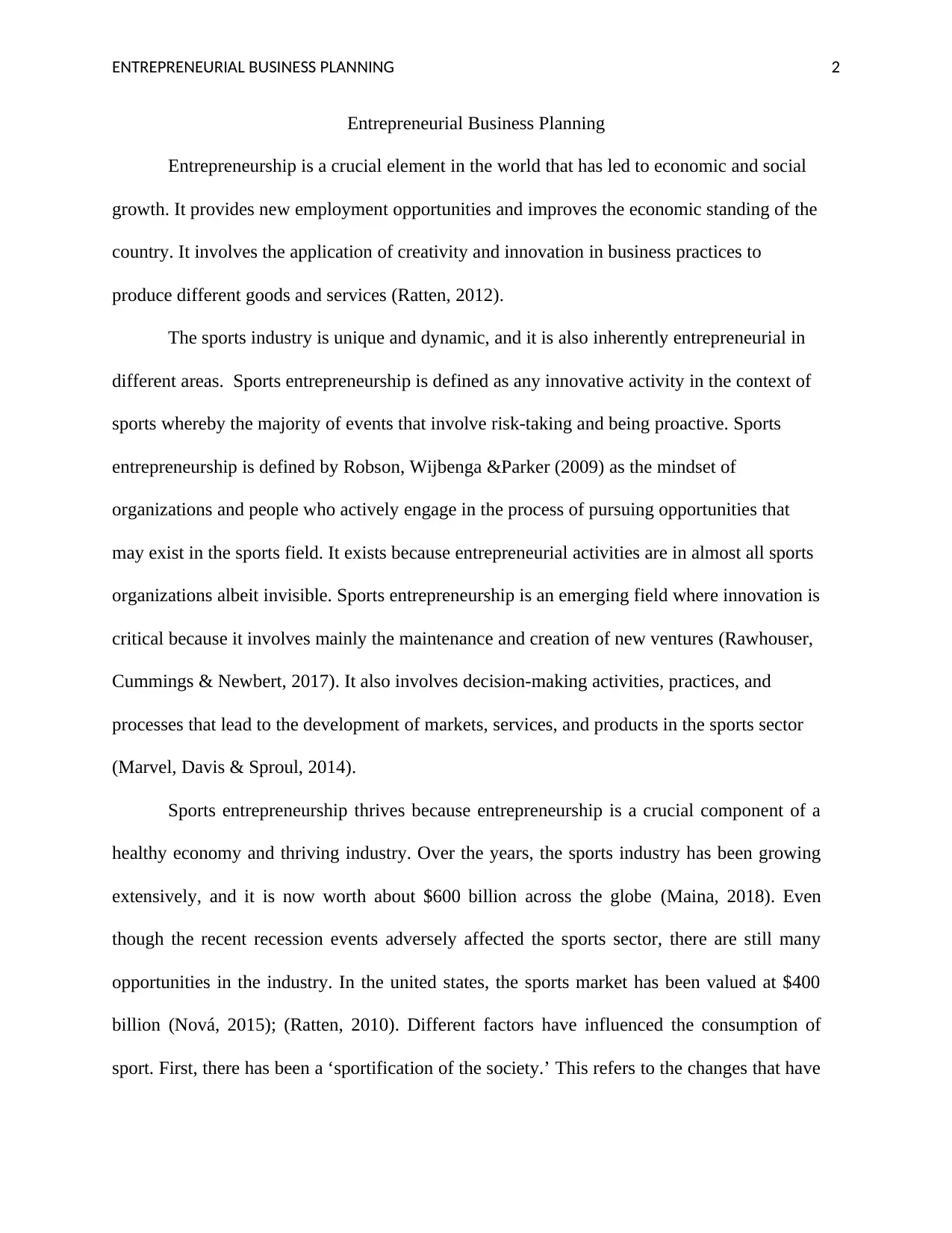
ENTREPRENEURIAL BUSINESS PLANNING 2
Entrepreneurial Business Planning
Entrepreneurship is a crucial element in the world that has led to economic and social
growth. It provides new employment opportunities and improves the economic standing of the
country. It involves the application of creativity and innovation in business practices to
produce different goods and services (Ratten, 2012).
The sports industry is unique and dynamic, and it is also inherently entrepreneurial in
different areas. Sports entrepreneurship is defined as any innovative activity in the context of
sports whereby the majority of events that involve risk-taking and being proactive. Sports
entrepreneurship is defined by Robson, Wijbenga &Parker (2009) as the mindset of
organizations and people who actively engage in the process of pursuing opportunities that
may exist in the sports field. It exists because entrepreneurial activities are in almost all sports
organizations albeit invisible. Sports entrepreneurship is an emerging field where innovation is
critical because it involves mainly the maintenance and creation of new ventures (Rawhouser,
Cummings & Newbert, 2017). It also involves decision-making activities, practices, and
processes that lead to the development of markets, services, and products in the sports sector
(Marvel, Davis & Sproul, 2014).
Sports entrepreneurship thrives because entrepreneurship is a crucial component of a
healthy economy and thriving industry. Over the years, the sports industry has been growing
extensively, and it is now worth about $600 billion across the globe (Maina, 2018). Even
though the recent recession events adversely affected the sports sector, there are still many
opportunities in the industry. In the united states, the sports market has been valued at $400
billion (Nová, 2015); (Ratten, 2010). Different factors have influenced the consumption of
sport. First, there has been a ‘sportification of the society.’ This refers to the changes that have
Entrepreneurial Business Planning
Entrepreneurship is a crucial element in the world that has led to economic and social
growth. It provides new employment opportunities and improves the economic standing of the
country. It involves the application of creativity and innovation in business practices to
produce different goods and services (Ratten, 2012).
The sports industry is unique and dynamic, and it is also inherently entrepreneurial in
different areas. Sports entrepreneurship is defined as any innovative activity in the context of
sports whereby the majority of events that involve risk-taking and being proactive. Sports
entrepreneurship is defined by Robson, Wijbenga &Parker (2009) as the mindset of
organizations and people who actively engage in the process of pursuing opportunities that
may exist in the sports field. It exists because entrepreneurial activities are in almost all sports
organizations albeit invisible. Sports entrepreneurship is an emerging field where innovation is
critical because it involves mainly the maintenance and creation of new ventures (Rawhouser,
Cummings & Newbert, 2017). It also involves decision-making activities, practices, and
processes that lead to the development of markets, services, and products in the sports sector
(Marvel, Davis & Sproul, 2014).
Sports entrepreneurship thrives because entrepreneurship is a crucial component of a
healthy economy and thriving industry. Over the years, the sports industry has been growing
extensively, and it is now worth about $600 billion across the globe (Maina, 2018). Even
though the recent recession events adversely affected the sports sector, there are still many
opportunities in the industry. In the united states, the sports market has been valued at $400
billion (Nová, 2015); (Ratten, 2010). Different factors have influenced the consumption of
sport. First, there has been a ‘sportification of the society.’ This refers to the changes that have

ENTREPRENEURIAL BUSINESS PLANNING 3
occurred in the social values and attitudes of the society as well as the economic and political
operations. Second, globalization has led to increased consumption of sports products.
Another factor that has increased sports consumption is democratization. Finally,
technological advances, economic development, implications for civic pride, and sports events
have also led to an increase in sports consumption (Ratten, 2011).
Organizations that are sports related usually create connections with different
stakeholders in and out of the sports industry and they also contribute to the national economy.
The various stakeholders include consumers, competitors, the government, professional
athletes, and sports managers.
The sports entrepreneurship industry is different from other consumer products and
businesses in a myriad of ways. The sports sector uses symbolic elements such as the teams
and athletes. It is also special regarding its promotion methods, finance, marketing, and in its
products. Additionally, it has high levels of unpredictability and inconsistency. It also makes
use of the celebrity status of different professional athletes. Finally, the sector is characterized
by a long product life cycle which is depicted by fluctuating seasonal demand (Hemme et al.,
2017).
Social entrepreneurship just like the entrepreneurship within any given firm is a factor
of both internal and external factors. The internal factors include organizational culture,
strategies, structure, and the personality of the various leaders. Conversely, the external factors
include government relations, product and market cycle, industry globalization, and the
environment. Sports entrepreneurship also follows the product life cycle just like any other
product. There is the introduction stage where different products and services are introduced
into the market, followed by the growth stage. In this stage, the sales revenue increases as the
occurred in the social values and attitudes of the society as well as the economic and political
operations. Second, globalization has led to increased consumption of sports products.
Another factor that has increased sports consumption is democratization. Finally,
technological advances, economic development, implications for civic pride, and sports events
have also led to an increase in sports consumption (Ratten, 2011).
Organizations that are sports related usually create connections with different
stakeholders in and out of the sports industry and they also contribute to the national economy.
The various stakeholders include consumers, competitors, the government, professional
athletes, and sports managers.
The sports entrepreneurship industry is different from other consumer products and
businesses in a myriad of ways. The sports sector uses symbolic elements such as the teams
and athletes. It is also special regarding its promotion methods, finance, marketing, and in its
products. Additionally, it has high levels of unpredictability and inconsistency. It also makes
use of the celebrity status of different professional athletes. Finally, the sector is characterized
by a long product life cycle which is depicted by fluctuating seasonal demand (Hemme et al.,
2017).
Social entrepreneurship just like the entrepreneurship within any given firm is a factor
of both internal and external factors. The internal factors include organizational culture,
strategies, structure, and the personality of the various leaders. Conversely, the external factors
include government relations, product and market cycle, industry globalization, and the
environment. Sports entrepreneurship also follows the product life cycle just like any other
product. There is the introduction stage where different products and services are introduced
into the market, followed by the growth stage. In this stage, the sales revenue increases as the
⊘ This is a preview!⊘
Do you want full access?
Subscribe today to unlock all pages.

Trusted by 1+ million students worldwide
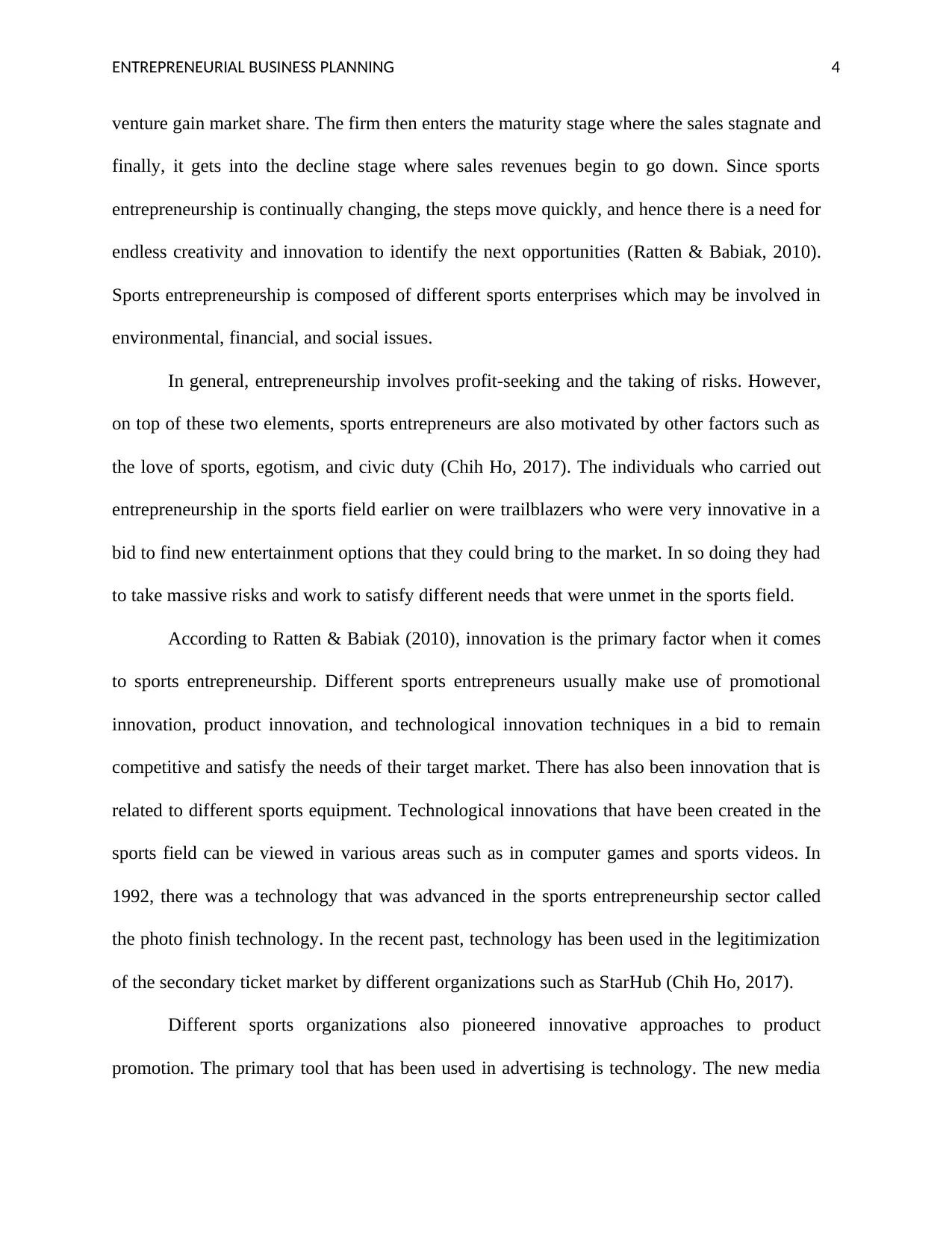
ENTREPRENEURIAL BUSINESS PLANNING 4
venture gain market share. The firm then enters the maturity stage where the sales stagnate and
finally, it gets into the decline stage where sales revenues begin to go down. Since sports
entrepreneurship is continually changing, the steps move quickly, and hence there is a need for
endless creativity and innovation to identify the next opportunities (Ratten & Babiak, 2010).
Sports entrepreneurship is composed of different sports enterprises which may be involved in
environmental, financial, and social issues.
In general, entrepreneurship involves profit-seeking and the taking of risks. However,
on top of these two elements, sports entrepreneurs are also motivated by other factors such as
the love of sports, egotism, and civic duty (Chih Ho, 2017). The individuals who carried out
entrepreneurship in the sports field earlier on were trailblazers who were very innovative in a
bid to find new entertainment options that they could bring to the market. In so doing they had
to take massive risks and work to satisfy different needs that were unmet in the sports field.
According to Ratten & Babiak (2010), innovation is the primary factor when it comes
to sports entrepreneurship. Different sports entrepreneurs usually make use of promotional
innovation, product innovation, and technological innovation techniques in a bid to remain
competitive and satisfy the needs of their target market. There has also been innovation that is
related to different sports equipment. Technological innovations that have been created in the
sports field can be viewed in various areas such as in computer games and sports videos. In
1992, there was a technology that was advanced in the sports entrepreneurship sector called
the photo finish technology. In the recent past, technology has been used in the legitimization
of the secondary ticket market by different organizations such as StarHub (Chih Ho, 2017).
Different sports organizations also pioneered innovative approaches to product
promotion. The primary tool that has been used in advertising is technology. The new media
venture gain market share. The firm then enters the maturity stage where the sales stagnate and
finally, it gets into the decline stage where sales revenues begin to go down. Since sports
entrepreneurship is continually changing, the steps move quickly, and hence there is a need for
endless creativity and innovation to identify the next opportunities (Ratten & Babiak, 2010).
Sports entrepreneurship is composed of different sports enterprises which may be involved in
environmental, financial, and social issues.
In general, entrepreneurship involves profit-seeking and the taking of risks. However,
on top of these two elements, sports entrepreneurs are also motivated by other factors such as
the love of sports, egotism, and civic duty (Chih Ho, 2017). The individuals who carried out
entrepreneurship in the sports field earlier on were trailblazers who were very innovative in a
bid to find new entertainment options that they could bring to the market. In so doing they had
to take massive risks and work to satisfy different needs that were unmet in the sports field.
According to Ratten & Babiak (2010), innovation is the primary factor when it comes
to sports entrepreneurship. Different sports entrepreneurs usually make use of promotional
innovation, product innovation, and technological innovation techniques in a bid to remain
competitive and satisfy the needs of their target market. There has also been innovation that is
related to different sports equipment. Technological innovations that have been created in the
sports field can be viewed in various areas such as in computer games and sports videos. In
1992, there was a technology that was advanced in the sports entrepreneurship sector called
the photo finish technology. In the recent past, technology has been used in the legitimization
of the secondary ticket market by different organizations such as StarHub (Chih Ho, 2017).
Different sports organizations also pioneered innovative approaches to product
promotion. The primary tool that has been used in advertising is technology. The new media
Paraphrase This Document
Need a fresh take? Get an instant paraphrase of this document with our AI Paraphraser
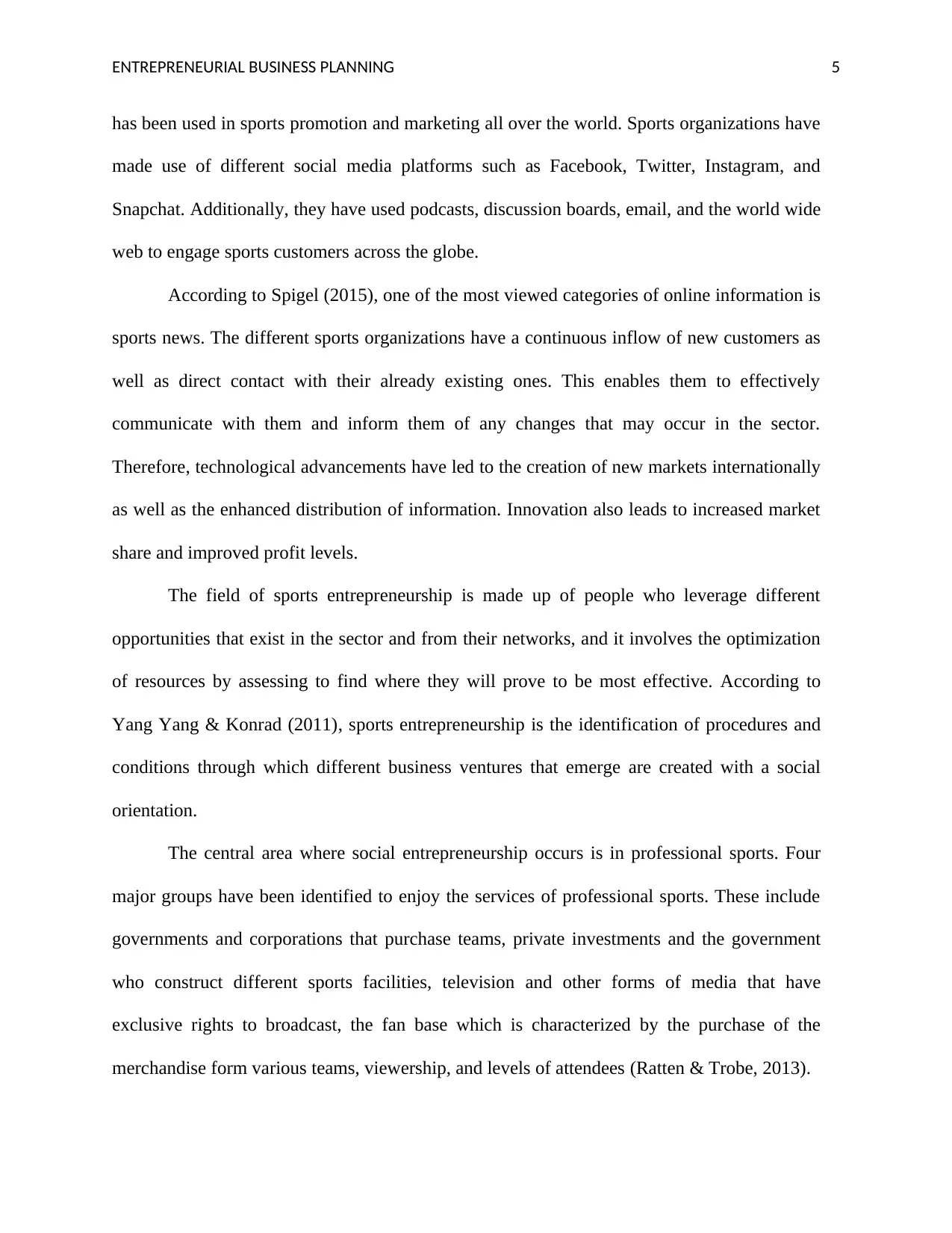
ENTREPRENEURIAL BUSINESS PLANNING 5
has been used in sports promotion and marketing all over the world. Sports organizations have
made use of different social media platforms such as Facebook, Twitter, Instagram, and
Snapchat. Additionally, they have used podcasts, discussion boards, email, and the world wide
web to engage sports customers across the globe.
According to Spigel (2015), one of the most viewed categories of online information is
sports news. The different sports organizations have a continuous inflow of new customers as
well as direct contact with their already existing ones. This enables them to effectively
communicate with them and inform them of any changes that may occur in the sector.
Therefore, technological advancements have led to the creation of new markets internationally
as well as the enhanced distribution of information. Innovation also leads to increased market
share and improved profit levels.
The field of sports entrepreneurship is made up of people who leverage different
opportunities that exist in the sector and from their networks, and it involves the optimization
of resources by assessing to find where they will prove to be most effective. According to
Yang Yang & Konrad (2011), sports entrepreneurship is the identification of procedures and
conditions through which different business ventures that emerge are created with a social
orientation.
The central area where social entrepreneurship occurs is in professional sports. Four
major groups have been identified to enjoy the services of professional sports. These include
governments and corporations that purchase teams, private investments and the government
who construct different sports facilities, television and other forms of media that have
exclusive rights to broadcast, the fan base which is characterized by the purchase of the
merchandise form various teams, viewership, and levels of attendees (Ratten & Trobe, 2013).
has been used in sports promotion and marketing all over the world. Sports organizations have
made use of different social media platforms such as Facebook, Twitter, Instagram, and
Snapchat. Additionally, they have used podcasts, discussion boards, email, and the world wide
web to engage sports customers across the globe.
According to Spigel (2015), one of the most viewed categories of online information is
sports news. The different sports organizations have a continuous inflow of new customers as
well as direct contact with their already existing ones. This enables them to effectively
communicate with them and inform them of any changes that may occur in the sector.
Therefore, technological advancements have led to the creation of new markets internationally
as well as the enhanced distribution of information. Innovation also leads to increased market
share and improved profit levels.
The field of sports entrepreneurship is made up of people who leverage different
opportunities that exist in the sector and from their networks, and it involves the optimization
of resources by assessing to find where they will prove to be most effective. According to
Yang Yang & Konrad (2011), sports entrepreneurship is the identification of procedures and
conditions through which different business ventures that emerge are created with a social
orientation.
The central area where social entrepreneurship occurs is in professional sports. Four
major groups have been identified to enjoy the services of professional sports. These include
governments and corporations that purchase teams, private investments and the government
who construct different sports facilities, television and other forms of media that have
exclusive rights to broadcast, the fan base which is characterized by the purchase of the
merchandise form various teams, viewership, and levels of attendees (Ratten & Trobe, 2013).
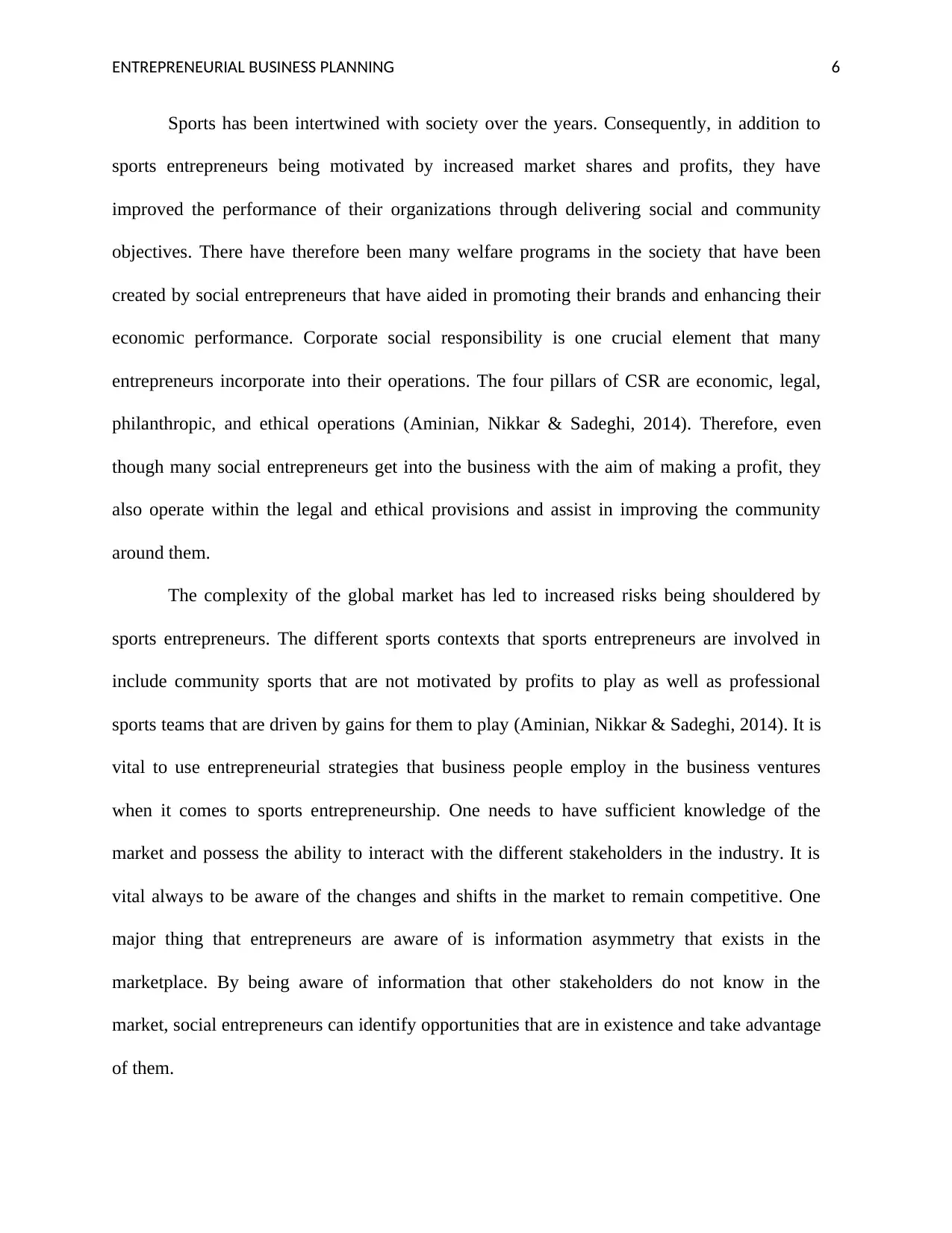
ENTREPRENEURIAL BUSINESS PLANNING 6
Sports has been intertwined with society over the years. Consequently, in addition to
sports entrepreneurs being motivated by increased market shares and profits, they have
improved the performance of their organizations through delivering social and community
objectives. There have therefore been many welfare programs in the society that have been
created by social entrepreneurs that have aided in promoting their brands and enhancing their
economic performance. Corporate social responsibility is one crucial element that many
entrepreneurs incorporate into their operations. The four pillars of CSR are economic, legal,
philanthropic, and ethical operations (Aminian, Nikkar & Sadeghi, 2014). Therefore, even
though many social entrepreneurs get into the business with the aim of making a profit, they
also operate within the legal and ethical provisions and assist in improving the community
around them.
The complexity of the global market has led to increased risks being shouldered by
sports entrepreneurs. The different sports contexts that sports entrepreneurs are involved in
include community sports that are not motivated by profits to play as well as professional
sports teams that are driven by gains for them to play (Aminian, Nikkar & Sadeghi, 2014). It is
vital to use entrepreneurial strategies that business people employ in the business ventures
when it comes to sports entrepreneurship. One needs to have sufficient knowledge of the
market and possess the ability to interact with the different stakeholders in the industry. It is
vital always to be aware of the changes and shifts in the market to remain competitive. One
major thing that entrepreneurs are aware of is information asymmetry that exists in the
marketplace. By being aware of information that other stakeholders do not know in the
market, social entrepreneurs can identify opportunities that are in existence and take advantage
of them.
Sports has been intertwined with society over the years. Consequently, in addition to
sports entrepreneurs being motivated by increased market shares and profits, they have
improved the performance of their organizations through delivering social and community
objectives. There have therefore been many welfare programs in the society that have been
created by social entrepreneurs that have aided in promoting their brands and enhancing their
economic performance. Corporate social responsibility is one crucial element that many
entrepreneurs incorporate into their operations. The four pillars of CSR are economic, legal,
philanthropic, and ethical operations (Aminian, Nikkar & Sadeghi, 2014). Therefore, even
though many social entrepreneurs get into the business with the aim of making a profit, they
also operate within the legal and ethical provisions and assist in improving the community
around them.
The complexity of the global market has led to increased risks being shouldered by
sports entrepreneurs. The different sports contexts that sports entrepreneurs are involved in
include community sports that are not motivated by profits to play as well as professional
sports teams that are driven by gains for them to play (Aminian, Nikkar & Sadeghi, 2014). It is
vital to use entrepreneurial strategies that business people employ in the business ventures
when it comes to sports entrepreneurship. One needs to have sufficient knowledge of the
market and possess the ability to interact with the different stakeholders in the industry. It is
vital always to be aware of the changes and shifts in the market to remain competitive. One
major thing that entrepreneurs are aware of is information asymmetry that exists in the
marketplace. By being aware of information that other stakeholders do not know in the
market, social entrepreneurs can identify opportunities that are in existence and take advantage
of them.
⊘ This is a preview!⊘
Do you want full access?
Subscribe today to unlock all pages.

Trusted by 1+ million students worldwide
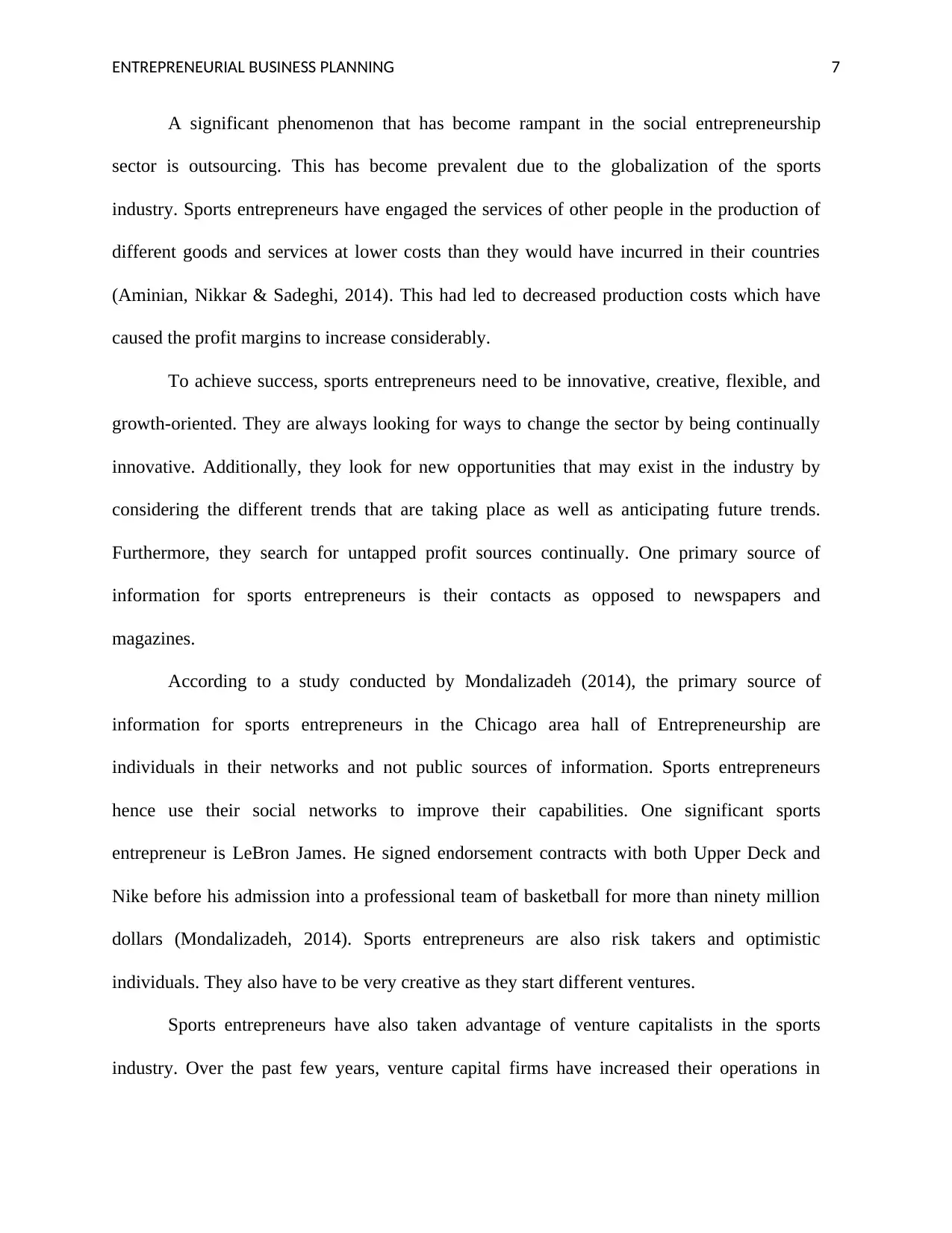
ENTREPRENEURIAL BUSINESS PLANNING 7
A significant phenomenon that has become rampant in the social entrepreneurship
sector is outsourcing. This has become prevalent due to the globalization of the sports
industry. Sports entrepreneurs have engaged the services of other people in the production of
different goods and services at lower costs than they would have incurred in their countries
(Aminian, Nikkar & Sadeghi, 2014). This had led to decreased production costs which have
caused the profit margins to increase considerably.
To achieve success, sports entrepreneurs need to be innovative, creative, flexible, and
growth-oriented. They are always looking for ways to change the sector by being continually
innovative. Additionally, they look for new opportunities that may exist in the industry by
considering the different trends that are taking place as well as anticipating future trends.
Furthermore, they search for untapped profit sources continually. One primary source of
information for sports entrepreneurs is their contacts as opposed to newspapers and
magazines.
According to a study conducted by Mondalizadeh (2014), the primary source of
information for sports entrepreneurs in the Chicago area hall of Entrepreneurship are
individuals in their networks and not public sources of information. Sports entrepreneurs
hence use their social networks to improve their capabilities. One significant sports
entrepreneur is LeBron James. He signed endorsement contracts with both Upper Deck and
Nike before his admission into a professional team of basketball for more than ninety million
dollars (Mondalizadeh, 2014). Sports entrepreneurs are also risk takers and optimistic
individuals. They also have to be very creative as they start different ventures.
Sports entrepreneurs have also taken advantage of venture capitalists in the sports
industry. Over the past few years, venture capital firms have increased their operations in
A significant phenomenon that has become rampant in the social entrepreneurship
sector is outsourcing. This has become prevalent due to the globalization of the sports
industry. Sports entrepreneurs have engaged the services of other people in the production of
different goods and services at lower costs than they would have incurred in their countries
(Aminian, Nikkar & Sadeghi, 2014). This had led to decreased production costs which have
caused the profit margins to increase considerably.
To achieve success, sports entrepreneurs need to be innovative, creative, flexible, and
growth-oriented. They are always looking for ways to change the sector by being continually
innovative. Additionally, they look for new opportunities that may exist in the industry by
considering the different trends that are taking place as well as anticipating future trends.
Furthermore, they search for untapped profit sources continually. One primary source of
information for sports entrepreneurs is their contacts as opposed to newspapers and
magazines.
According to a study conducted by Mondalizadeh (2014), the primary source of
information for sports entrepreneurs in the Chicago area hall of Entrepreneurship are
individuals in their networks and not public sources of information. Sports entrepreneurs
hence use their social networks to improve their capabilities. One significant sports
entrepreneur is LeBron James. He signed endorsement contracts with both Upper Deck and
Nike before his admission into a professional team of basketball for more than ninety million
dollars (Mondalizadeh, 2014). Sports entrepreneurs are also risk takers and optimistic
individuals. They also have to be very creative as they start different ventures.
Sports entrepreneurs have also taken advantage of venture capitalists in the sports
industry. Over the past few years, venture capital firms have increased their operations in
Paraphrase This Document
Need a fresh take? Get an instant paraphrase of this document with our AI Paraphraser
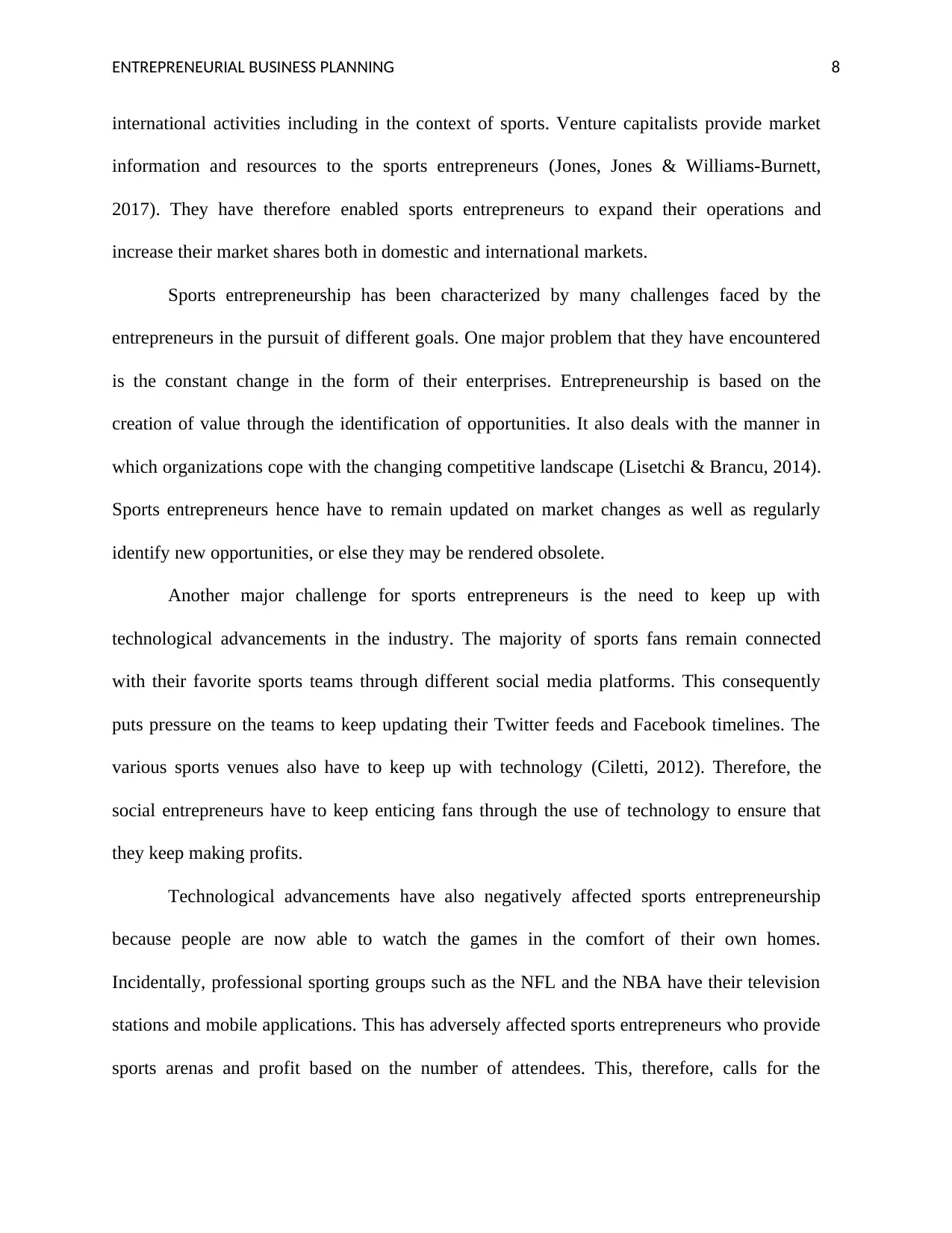
ENTREPRENEURIAL BUSINESS PLANNING 8
international activities including in the context of sports. Venture capitalists provide market
information and resources to the sports entrepreneurs (Jones, Jones & Williams-Burnett,
2017). They have therefore enabled sports entrepreneurs to expand their operations and
increase their market shares both in domestic and international markets.
Sports entrepreneurship has been characterized by many challenges faced by the
entrepreneurs in the pursuit of different goals. One major problem that they have encountered
is the constant change in the form of their enterprises. Entrepreneurship is based on the
creation of value through the identification of opportunities. It also deals with the manner in
which organizations cope with the changing competitive landscape (Lisetchi & Brancu, 2014).
Sports entrepreneurs hence have to remain updated on market changes as well as regularly
identify new opportunities, or else they may be rendered obsolete.
Another major challenge for sports entrepreneurs is the need to keep up with
technological advancements in the industry. The majority of sports fans remain connected
with their favorite sports teams through different social media platforms. This consequently
puts pressure on the teams to keep updating their Twitter feeds and Facebook timelines. The
various sports venues also have to keep up with technology (Ciletti, 2012). Therefore, the
social entrepreneurs have to keep enticing fans through the use of technology to ensure that
they keep making profits.
Technological advancements have also negatively affected sports entrepreneurship
because people are now able to watch the games in the comfort of their own homes.
Incidentally, professional sporting groups such as the NFL and the NBA have their television
stations and mobile applications. This has adversely affected sports entrepreneurs who provide
sports arenas and profit based on the number of attendees. This, therefore, calls for the
international activities including in the context of sports. Venture capitalists provide market
information and resources to the sports entrepreneurs (Jones, Jones & Williams-Burnett,
2017). They have therefore enabled sports entrepreneurs to expand their operations and
increase their market shares both in domestic and international markets.
Sports entrepreneurship has been characterized by many challenges faced by the
entrepreneurs in the pursuit of different goals. One major problem that they have encountered
is the constant change in the form of their enterprises. Entrepreneurship is based on the
creation of value through the identification of opportunities. It also deals with the manner in
which organizations cope with the changing competitive landscape (Lisetchi & Brancu, 2014).
Sports entrepreneurs hence have to remain updated on market changes as well as regularly
identify new opportunities, or else they may be rendered obsolete.
Another major challenge for sports entrepreneurs is the need to keep up with
technological advancements in the industry. The majority of sports fans remain connected
with their favorite sports teams through different social media platforms. This consequently
puts pressure on the teams to keep updating their Twitter feeds and Facebook timelines. The
various sports venues also have to keep up with technology (Ciletti, 2012). Therefore, the
social entrepreneurs have to keep enticing fans through the use of technology to ensure that
they keep making profits.
Technological advancements have also negatively affected sports entrepreneurship
because people are now able to watch the games in the comfort of their own homes.
Incidentally, professional sporting groups such as the NFL and the NBA have their television
stations and mobile applications. This has adversely affected sports entrepreneurs who provide
sports arenas and profit based on the number of attendees. This, therefore, calls for the

ENTREPRENEURIAL BUSINESS PLANNING 9
construction of sports facilities that entertain fans in a way that cannot be replicated in their
own homes (Ratten & Trobe, 2013). There has also been a decrease in public support for
sports projects causing some sports entrepreneurship ventures to incur losses. Finally, there
has been a reduction in public safety which has caused many fans not to participate in sports
events.
One theory that explains sports entrepreneurship is the theory of planned behavior.
According to this theory, an individual’s behavior and intentions are determined by their
perceived behavioral control, subjective norms, and attitudes towards different behavior
(Whelan & Msefer, 2006). Initially, the theory of planned behavior started as the theory of
reasoned action which was used in the prediction of a person’s intentions to carry out specific
activities at a given place and time.
The theory of planned behavior now states that the achievement that one makes is
dependent on both abilities which are influenced by behavioral control and motivation (Yang
Yang & Konrad, 2011). This theory applies to sports entrepreneurship because this field
requires one to have a positive attitude in different entrepreneurial activities. One also needs to
be highly motivated to bring about productivity and keep being innovative even when things
do not go as intended as is the case sometimes.
Additionally, subjective norms are put into consideration in sports entrepreneurship
because one needs to ensure that people will approve of the products and services being
offered. Social norms are also critical elements which end up being changed in some cases
when sports entrepreneurs introduce new products into the market (Spigel, 2015). The theory
of planned behavior, therefore, relates directly to sports entrepreneurship because the
construction of sports facilities that entertain fans in a way that cannot be replicated in their
own homes (Ratten & Trobe, 2013). There has also been a decrease in public support for
sports projects causing some sports entrepreneurship ventures to incur losses. Finally, there
has been a reduction in public safety which has caused many fans not to participate in sports
events.
One theory that explains sports entrepreneurship is the theory of planned behavior.
According to this theory, an individual’s behavior and intentions are determined by their
perceived behavioral control, subjective norms, and attitudes towards different behavior
(Whelan & Msefer, 2006). Initially, the theory of planned behavior started as the theory of
reasoned action which was used in the prediction of a person’s intentions to carry out specific
activities at a given place and time.
The theory of planned behavior now states that the achievement that one makes is
dependent on both abilities which are influenced by behavioral control and motivation (Yang
Yang & Konrad, 2011). This theory applies to sports entrepreneurship because this field
requires one to have a positive attitude in different entrepreneurial activities. One also needs to
be highly motivated to bring about productivity and keep being innovative even when things
do not go as intended as is the case sometimes.
Additionally, subjective norms are put into consideration in sports entrepreneurship
because one needs to ensure that people will approve of the products and services being
offered. Social norms are also critical elements which end up being changed in some cases
when sports entrepreneurs introduce new products into the market (Spigel, 2015). The theory
of planned behavior, therefore, relates directly to sports entrepreneurship because the
⊘ This is a preview!⊘
Do you want full access?
Subscribe today to unlock all pages.

Trusted by 1+ million students worldwide
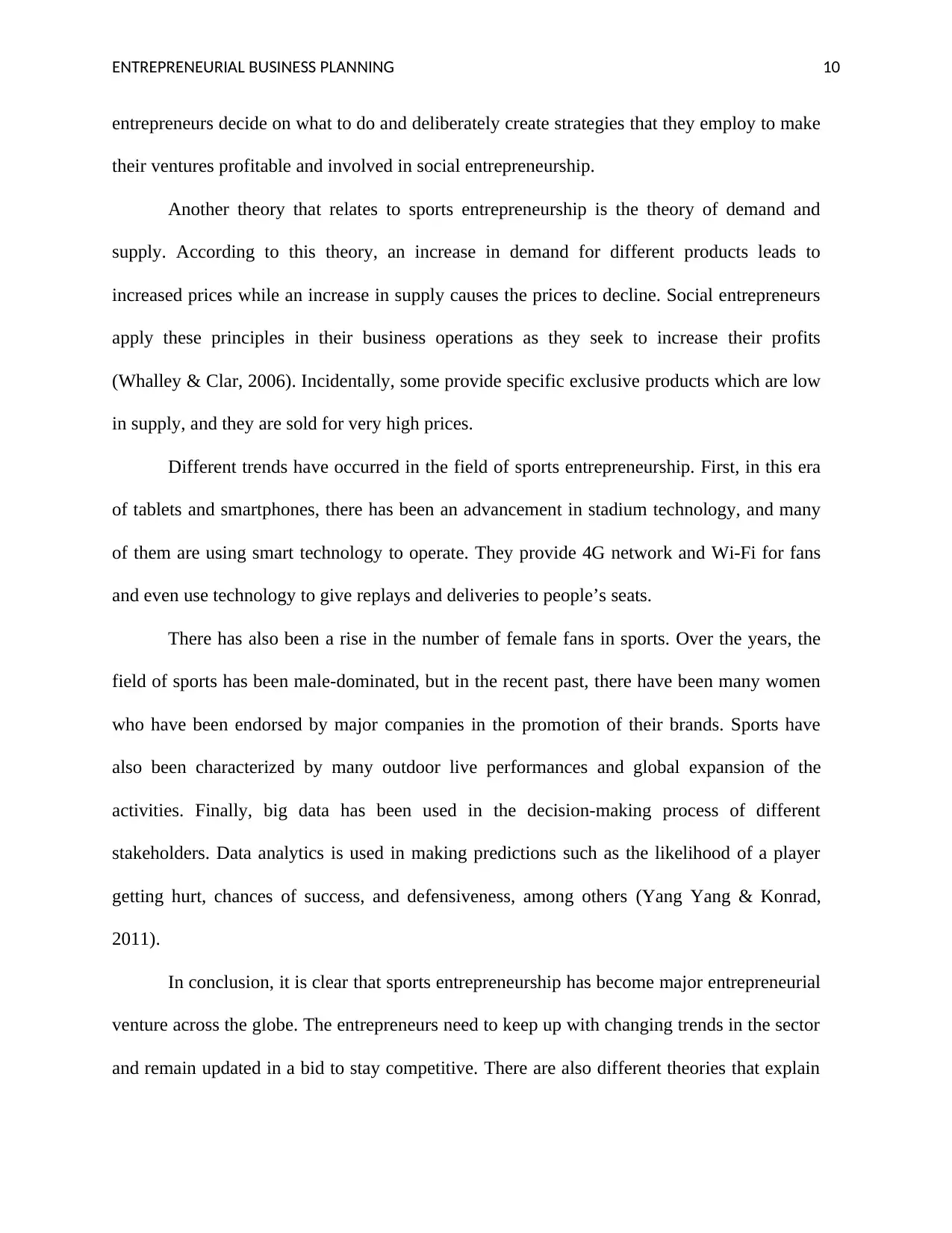
ENTREPRENEURIAL BUSINESS PLANNING 10
entrepreneurs decide on what to do and deliberately create strategies that they employ to make
their ventures profitable and involved in social entrepreneurship.
Another theory that relates to sports entrepreneurship is the theory of demand and
supply. According to this theory, an increase in demand for different products leads to
increased prices while an increase in supply causes the prices to decline. Social entrepreneurs
apply these principles in their business operations as they seek to increase their profits
(Whalley & Clar, 2006). Incidentally, some provide specific exclusive products which are low
in supply, and they are sold for very high prices.
Different trends have occurred in the field of sports entrepreneurship. First, in this era
of tablets and smartphones, there has been an advancement in stadium technology, and many
of them are using smart technology to operate. They provide 4G network and Wi-Fi for fans
and even use technology to give replays and deliveries to people’s seats.
There has also been a rise in the number of female fans in sports. Over the years, the
field of sports has been male-dominated, but in the recent past, there have been many women
who have been endorsed by major companies in the promotion of their brands. Sports have
also been characterized by many outdoor live performances and global expansion of the
activities. Finally, big data has been used in the decision-making process of different
stakeholders. Data analytics is used in making predictions such as the likelihood of a player
getting hurt, chances of success, and defensiveness, among others (Yang Yang & Konrad,
2011).
In conclusion, it is clear that sports entrepreneurship has become major entrepreneurial
venture across the globe. The entrepreneurs need to keep up with changing trends in the sector
and remain updated in a bid to stay competitive. There are also different theories that explain
entrepreneurs decide on what to do and deliberately create strategies that they employ to make
their ventures profitable and involved in social entrepreneurship.
Another theory that relates to sports entrepreneurship is the theory of demand and
supply. According to this theory, an increase in demand for different products leads to
increased prices while an increase in supply causes the prices to decline. Social entrepreneurs
apply these principles in their business operations as they seek to increase their profits
(Whalley & Clar, 2006). Incidentally, some provide specific exclusive products which are low
in supply, and they are sold for very high prices.
Different trends have occurred in the field of sports entrepreneurship. First, in this era
of tablets and smartphones, there has been an advancement in stadium technology, and many
of them are using smart technology to operate. They provide 4G network and Wi-Fi for fans
and even use technology to give replays and deliveries to people’s seats.
There has also been a rise in the number of female fans in sports. Over the years, the
field of sports has been male-dominated, but in the recent past, there have been many women
who have been endorsed by major companies in the promotion of their brands. Sports have
also been characterized by many outdoor live performances and global expansion of the
activities. Finally, big data has been used in the decision-making process of different
stakeholders. Data analytics is used in making predictions such as the likelihood of a player
getting hurt, chances of success, and defensiveness, among others (Yang Yang & Konrad,
2011).
In conclusion, it is clear that sports entrepreneurship has become major entrepreneurial
venture across the globe. The entrepreneurs need to keep up with changing trends in the sector
and remain updated in a bid to stay competitive. There are also different theories that explain
Paraphrase This Document
Need a fresh take? Get an instant paraphrase of this document with our AI Paraphraser

ENTREPRENEURIAL BUSINESS PLANNING 11
the operations of sports entrepreneurs such as the theory of demand and supply and that of
planned behavior. Finally, it is clear that sports entrepreneurs need to be innovative, creative,
optimistic, and take risks for them to succeed in this sector.
References
Aminian, E., Nikkar, H. & Sadeghi, S. (2014). The importance of sports entrepreneurship by
providing appropriate strategy based on views of sports managers. International
Conference on Arts, Economics and Management.
Chih Ho, J. (2017). The effect of supervisor support on employee voice behavior based on the
self-determination theory: The moderating effect of impression management
motive. Journal of Entrepreneurship & Organization Management, 06(01).
Ciletti, D. (2012). Sports entrepreneurship: A theoretical approach.
Hemme, F., Morais, D., Bowers, M. & Todd, J. (2017). Extending sport-based entrepreneurship
theory through phenomenological inquiry. Sports Management Review, 20(1), pp.92-104.
Jones, P., Jones, A. & Williams-Burnett, N. (2017). Let’s get physical stories of entrepreneurial
activity from sports coaches/instructors. The International Journal of Entrepreneurship
and Innovation. Retrieved from
http://journals.sagepub.com/doi/abs/10.1177/1465750317741878 [Accessed 19 May
2018].
Lisetchi, M. & Brancu, L. (2014). The entrepreneurship concept as a subject of social
innovation. Procedia - Social and Behavioral Sciences, 124(20). Retrieved from
https://www.sciencedirect.com/science/article/pii/S1877042814020114
Maina, P. (2018). Sports entrepreneurship. Kuzabiashara.co.ke. Retrieved from
http://www.kuzabiashara.co.ke/sports-entrepreneurship-23435
the operations of sports entrepreneurs such as the theory of demand and supply and that of
planned behavior. Finally, it is clear that sports entrepreneurs need to be innovative, creative,
optimistic, and take risks for them to succeed in this sector.
References
Aminian, E., Nikkar, H. & Sadeghi, S. (2014). The importance of sports entrepreneurship by
providing appropriate strategy based on views of sports managers. International
Conference on Arts, Economics and Management.
Chih Ho, J. (2017). The effect of supervisor support on employee voice behavior based on the
self-determination theory: The moderating effect of impression management
motive. Journal of Entrepreneurship & Organization Management, 06(01).
Ciletti, D. (2012). Sports entrepreneurship: A theoretical approach.
Hemme, F., Morais, D., Bowers, M. & Todd, J. (2017). Extending sport-based entrepreneurship
theory through phenomenological inquiry. Sports Management Review, 20(1), pp.92-104.
Jones, P., Jones, A. & Williams-Burnett, N. (2017). Let’s get physical stories of entrepreneurial
activity from sports coaches/instructors. The International Journal of Entrepreneurship
and Innovation. Retrieved from
http://journals.sagepub.com/doi/abs/10.1177/1465750317741878 [Accessed 19 May
2018].
Lisetchi, M. & Brancu, L. (2014). The entrepreneurship concept as a subject of social
innovation. Procedia - Social and Behavioral Sciences, 124(20). Retrieved from
https://www.sciencedirect.com/science/article/pii/S1877042814020114
Maina, P. (2018). Sports entrepreneurship. Kuzabiashara.co.ke. Retrieved from
http://www.kuzabiashara.co.ke/sports-entrepreneurship-23435

ENTREPRENEURIAL BUSINESS PLANNING 12
Marvel, M., Davis, J., and Sproul, C. (2014). Human capital and entrepreneurship research: A
critical review and future directions. Entrepreneurship Theory and Practice, 40(3),
pp.599-626.
Mondalizadeh, Z. (2014). Determining the challenges of entrepreneurship in sports colleges in
Iran from the view point of specialists. SSRN.
Nová, J. (2015). Developing the entrepreneurial competencies of sports management
students. Procedia - Social and Behavioral Sciences, 174, pp.3916-3924.
Ratten, V. (2012). Sport entrepreneurship: challenges and directions for future
research. International Journal of Entrepreneurial Venturing, 4(1), p.65.
Ratten, V. & Trobe, L. (2013). Sports innovation: The role of social entrepreneurship and
creativity in fostering sport related business activities.
Ratten, V. (2010). Developing a theory of sport-based entrepreneurship. Journal of Management
& Organization, 16(4), pp.557-565.
Ratten, V. & Babiak, K. (2010). The role of social responsibility, philanthropy, and
entrepreneurship in the sports industry. Journal of Management & Organization, 16(04),
pp.482-487.
Rawhouser, H., Cummings, M., & Newbert, S. (2017). Social impact measurement: Current
approaches and future directions for social entrepreneurship research. Entrepreneurship
Theory and Practice.
Robson, P., Wijbenga, F. & Parker, S. (2009). Entrepreneurship and policy: Challenges and
directions for future research. International Small Business Journal, 27(5), pp.531-535.
Spigel, B. (2015). The Relational organization of entrepreneurial ecosystems. Entrepreneurship
Theory and Practice, 41(1), pp.49-72.
Marvel, M., Davis, J., and Sproul, C. (2014). Human capital and entrepreneurship research: A
critical review and future directions. Entrepreneurship Theory and Practice, 40(3),
pp.599-626.
Mondalizadeh, Z. (2014). Determining the challenges of entrepreneurship in sports colleges in
Iran from the view point of specialists. SSRN.
Nová, J. (2015). Developing the entrepreneurial competencies of sports management
students. Procedia - Social and Behavioral Sciences, 174, pp.3916-3924.
Ratten, V. (2012). Sport entrepreneurship: challenges and directions for future
research. International Journal of Entrepreneurial Venturing, 4(1), p.65.
Ratten, V. & Trobe, L. (2013). Sports innovation: The role of social entrepreneurship and
creativity in fostering sport related business activities.
Ratten, V. (2010). Developing a theory of sport-based entrepreneurship. Journal of Management
& Organization, 16(4), pp.557-565.
Ratten, V. & Babiak, K. (2010). The role of social responsibility, philanthropy, and
entrepreneurship in the sports industry. Journal of Management & Organization, 16(04),
pp.482-487.
Rawhouser, H., Cummings, M., & Newbert, S. (2017). Social impact measurement: Current
approaches and future directions for social entrepreneurship research. Entrepreneurship
Theory and Practice.
Robson, P., Wijbenga, F. & Parker, S. (2009). Entrepreneurship and policy: Challenges and
directions for future research. International Small Business Journal, 27(5), pp.531-535.
Spigel, B. (2015). The Relational organization of entrepreneurial ecosystems. Entrepreneurship
Theory and Practice, 41(1), pp.49-72.
⊘ This is a preview!⊘
Do you want full access?
Subscribe today to unlock all pages.

Trusted by 1+ million students worldwide
1 out of 13
Related Documents
Your All-in-One AI-Powered Toolkit for Academic Success.
+13062052269
info@desklib.com
Available 24*7 on WhatsApp / Email
![[object Object]](/_next/static/media/star-bottom.7253800d.svg)
Unlock your academic potential
Copyright © 2020–2025 A2Z Services. All Rights Reserved. Developed and managed by ZUCOL.



